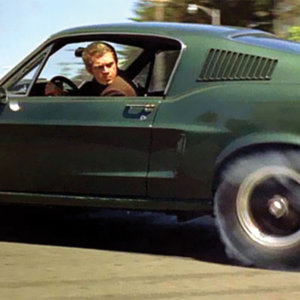Stories That Deliver Business Insights
Ethnographic stories offer executives an empathic understanding of how consumers live, work and play through gritty and detailed descriptions. What you learn from ethnographic stories may surprise you — and change your company’s strategy.

Ford executives used insights gained from ethnographic observations when redesigning the Ford Mustang and developing a new marketing strategy for the car.
Image courtesy of Warner Bros.-Seven Arts
The data from the rollout of the new Mustang confused Ford executives.
After a redesigned Ford Mustang was released in the late 1990s, consumers reported finding the new car less powerful than previous incarnations. That feedback troubled Ford engineers, because the iconic vehicle’s power was objectively higher in this version than in earlier models.
To find out what was going on, Ford dispatched a team from a consulting company to ride along as Mustang owners drove their new cars. From their interviews and observations, the ethnographers — a team of social scientists dedicated to studying people in their natural environments — concluded that power was something drivers experienced viscerally. They sensed it bodily when in contact with the car’s vibrations while they drove. They absorbed it audibly when exposed to the “voice box” of the car’s engine. And they grasped it visually when their eyes took in the Mustang’s look. The ethnographers concluded that car performance was fundamentally a sensory, bodily experience rather than just a set of horsepower statistics.
In light of that information, Ford engineers literally returned to the drawing board. They refashioned the exterior styling of the car so that it “looked fast,” making the new Mustang much more like the iconic models of the 1960s. As Ford Design California chief Richard Hutting said of the redesigned car, “This vehicle has that sense of motion, even when it’s standing still. It captures your eye from 50 feet away — it’s instantly recognizable as a Mustang.”1
Furthermore, ethnographic observations eased the Ford marketing team’s fears that an aging target market was diluting the brand’s equity. The ethnographers discovered that the Mustang, as much as it was a fantastic set of wheels, also fueled fantasies of youth. No matter how old they were, the car’s buyers desired the same thing: the feelings of youth, irresponsibility and assertiveness that the original Mustang delivered. Driving and owning a Mustang gave baby boomers, a core market segment squeezed between work and family commitments, an emotional high. A Mustang was often the only irresponsible pleasure they allowed themselves. This insight allowed Ford to embrace the brand’s heritage and nostalgia rather than “modernizing” it.
About the Authors
Julien Cayla is an assistant professor of marketing at Nanyang Technological University in Singapore, a research fellow at the Institute on Asian Consumer Insight and a visiting professor at KEDGE Business School. Robin Beers is senior vice president, customer experience insights, in the wholesale Internet solutions group for Wells Fargo Bank, N.A. Eric Arnould is a professor of consumer marketing at the University of Bath in Bath, U.K., and a visiting professor of marketing at Southern Denmark University.
References
1. B. Gritzinger, “Fast Glory,” AutoWeek, Jan. 27, 2003, 14.
2. See, for example, H. Mariampolski, “Ethnography for Marketers: A Guide to Consumer Immersion” (Thousand Oaks, California: Sage, 2006); and N. Malhotra, J. Hall, M. Shaw and P. Oppenheim, “Marketing Research: An Applied Orientation,” 3rd ed. (Frenchs Forest, New South Wales, Australia: Pearson Education Australia, 2006).
3. S. Sthanunathan, “Research Must Change” (keynote address at the Advertising Research Foundation Re:think Convention, New York, March 20-23, 2011).
4. M.C. Green and T.C. Brock, “The Role of Transportation in the Persuasiveness of Public Narratives,” Journal of Personality and Social Psychology 79, no. 5 (November 2000): 701-721.
5. A considerable amount of research has highlighted the distinctive benefits of narrative sense-making. We have been especially influenced by the writings of the psychologist Jerome Bruner. See, for example, J. Bruner, “The Narrative Construction of Reality,” Critical Inquiry 18, no. 1 (autumn 1991): 1-21; J. Bruner, “Actual Minds, Possible Worlds” (Cambridge, Massachusetts: Harvard University Press, 1986); and J. Bruner, “What Is a Narrative Fact?,” Annals of the American Academy of Political and Social Science 560 (November 1998): 17-27.
6. R. McKee and B. Fryer, “Storytelling That Moves People,” Harvard Business Review 81 (May-June 2003): 51-55.
i. For more details on this research program and the power of ethnographic stories, see J. Cayla and E. Arnould, “Ethnographic Stories for Market Learning,” Journal of Marketing 77, no. 4 (July 2013): 1-16.
ii. B. Kerschberg, “How Xerox Uses Analytics, Big Data and Ethnography to Help Government Solve Big Problems,” October 22, 2012, Forbes.com.
iii. K. Anderson, D. Nafus, T. Rattenbury and R. Aipperspach, “Numbers Have Qualities Too: Experiences with Ethno-Mining,” Ethnographic Praxis in Industry Conference Proceedings (August 2009): 123-140.
iv. McKee and Fryer, “Storytelling That Moves People.”
Reprint #:
55223















![Toni Kroos là ai? [ sự thật về tiểu sử đầy đủ Toni Kroos ]](https://evbn.org/wp-content/uploads/New-Project-6635-1671934592.jpg)


